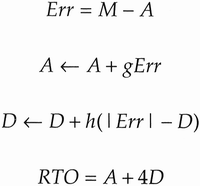21.3 Round-Trip Time Measurement
21.3 Round-Trip Time Measurement
Fundamental to TCP's timeout and retransmission is the measurement of the round-trip time (RTT) experienced on a given connection. We expect this can change over time, as routes might change and as network traffic changes, and TCP should track these changes and modify its timeout accordingly .
First TCP must measure the RTT between sending a byte with a particular sequence number and receiving an acknowledgment that covers that sequence number. Recall from the previous chapter that normally there is not a one-to-one correspondence between data segments and ACKs. In Figure 20.1 this means that one RTT that can be measured by the sender is the time between the transmission of segment 4 (data bytes 1-1024) and the reception of segment 7 (the ACK of bytes 1-2048), even though this ACK is for an additional 1024 bytes. We'll use M to denote the measured RTT.
The original TCP specification had TCP update a smoothed RTT estimator (called R ) using the low-pass filter
where a is a smoothing factor with a recommended value of 0.9. This smoothed RTT is updated every time a new measurement is made. Ninety percent of each new estimate is from the previous estimate and 10% is from the new measurement.
Given this smoothed estimator, which changes as the RTT changes, RFC 793 recommended the retransmission timeout value ( RTO ) be set to
where is a delay variance factor with a recommended value of 2.
[Jacobson 1988] details the problems with this approach, basically that it can't keep up with wide fluctuations in the RTT, causing unnecessary retransmissions. As Jacobson notes, unnecessary retransmissions add to the network load, when the network is already loaded. It is the network equivalent of pouring gasoline on a fire.
What's needed is to keep track of the variance in the RTT measurements, in addition to the smoothed RTT estimator. Calculating the RTO based on both the mean and variance provides much better response to wide fluctuations in the round-trip times, than just calculating the RTO as a constant multiple of the mean. Figures 5 and 6 in [Jacobson 1988] show a comparison of the RFC 793 RTO values for some actual round-trip times, versus the RTO calculations we show below, which take into account the variance of the round-trip times.
As described by Jacobson, the mean deviation is a good approximation to the standard deviation, but easier to compute. (Calculating the standard deviation requires a square root.) This leads to the following equations that are applied to each RTT measurement M .

where A is the smoothed RTT (an estimator of the average) and D is the smoothed mean deviation. Err is the difference between the measured value just obtained and the current RTT estimator. Both A and D are used to calculate the next retransmission timeout ( RTO ). The gain g is for the average and is set to 1/8 (0.125). The gain for the deviation is h and is set to 0.25. The larger gain for the deviation makes the RTO go up faster when the RTT changes.
[Jacobson 1988] specified 2 D in the calculation of RTO, but after further research, [Jacobson 1990c] changed the value to 4 D, which is what appeared in the BSD Net/1 implementation.
Jacobson specifies a way to do all these calculations using integer arithmetic, and this is the implementation typically used. (That's one reason g, h, and the multiplier 4 are all powers of 2, so the operations can be done using shifts instead of multiplies and divides.)
Comparing the original method with Jacobson's, we see that the calculations of the smoothed average are similar ( a is one minus the gain g ) but a different gain is used. Also, Jacobson's calculation of the RTO depends on both the smoothed RTT and the smoothed mean deviation, whereas the original method used a multiple of the smoothed RTT.
We'll see how these estimators are initialized in the next section, when we go through an example.
Karn's Algorithm
A problem occurs when a packet is retransmitted. Say a packet is transmitted, a timeout occurs, the RTO is backed off as shown in Section 21.2, the packet is retransmitted with the longer RTO, and an acknowledgment is received. Is the ACK for the first transmission or the second? This is called the retransmission ambiguity problem.
[Karn and Partridge 1987] specify that when a timeout and retransmission occur, we cannot update the RTT estimators when the acknowledgment for the retransmitted data finally arrives. This is because we don't know to which transmission the ACK corresponds. (Perhaps the first transmission was delayed and not thrown away, or perhaps the ACK of the first transmission was delayed.)
Also, since the data was retransmitted, and the exponential backoff has been applied to the RTO, we reuse this backed off RTO for the next transmission. Don't calculate a new RTO until an acknowledgment is received for a segment that was not retransmitted.
EAN: 2147483647
Pages: 378